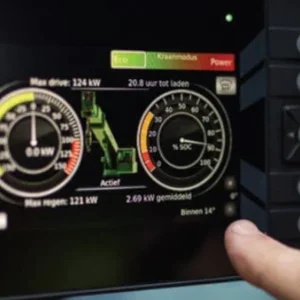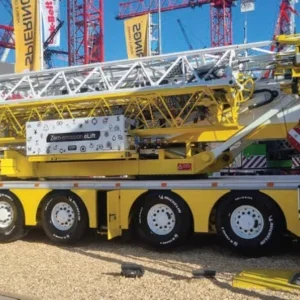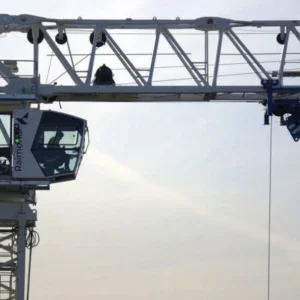Wire rope sheaves in cranes are one of the critical structural components that must maintain their structural integrity at all times and in all physical environments to ensure safe crane operation in the field. Sheave failure can lead to severe accidents.
Polyamide sheaves, however, provide many benefits to crane operators and owners. They are lighter than conventional steel sheaves, enabling higher payloads to be lifted for the same boom head configuration. In addition, they induce less wear on the rope than steel sheaves.
The background
Polyamide sheaves have been used by various manufacturers in telescopic and crawler cranes for more than 25 years. More recently, however, several incidents have come to light with large diameter wire rope sheaves in hot and generally humid climates, which have resulted in polyamide sheave failures during high sheave loading applications. This has cast a degree of doubt on all cranes that use polyamide sheaves, and some crane users have asked the manufacturers what they are doing to ensure the safety of their polyamide sheaves at high and low temperatures.
Liebherr has never had a problem with polyamide sheaves on any of its cranes and, being reluctant to change to steel, has therefore chosen to defend its use of polyamide.
The problem
Foster Wheeler, an international engineering and construction company that has managed and operated many different machines from manufacturers and operating companies worldwide, played an instrumental role in detecting a failure pattern associated with polyamide sheaves in certain heavylift cranes.
It found common denominators associated with these failures, namely:
• sheaves made from a polyamide PA 6G or similar replacement material in replacement sheaves (not all records are accurate enough to determine if all sheaves were the manufacturers’ standard sheaves)
• high ambient temperature conditions, such as Malaysia, Gulf Coast of the USA, Iran and Australia
• sites subjected to high ambient humidity
• large diameter ropes with correspondingly large diameter sheaves (to maintain the appropriate d/D ratio – rope diameter to sheave diameter).
Failure could have been due to:
• a design defect
• a change in the material properties (such as reduced strength in higher temperatures)
• a maintenance problem.
The reaction
To date, information regarding the cause of these failures (eg sheave properties conducive to failures, temperature/humidity effects on material properties, etc.) has been insufficient to permit crane operators/hirers to take effective counteractive measures while continuing to use these sheaves.
Thus, to maintain the highest safety standards for personnel and equipment, Foster Wheeler raised the profile of this problem with crane operators, contractually prohibiting the use of polyamide sheaves in heavylift cranes on its sites. Operators were challenged to substantiate the integrity of their polyamide sheaves under extreme ambient temperature and humidity expected on projects, as well as wire rope diameters and line pulls associated with their equipment. The contractual ban would be lifted only if enough technical evidence was presented to support the adequacy of the polyamide sheaves.
Convinced that their polyamide sheaves were fit for this purpose and designed accordingly, Liebherr and its supplier Schwartz invited William Meyer of Foster Wheeler to look more closely at the design and specifications of their polyamide sheaves, and to review tests undertaken to prove their performance. After that visit, Liebherr cranes received the ‘green light’ to work on Foster Wheeler sites with its polyamide sheaves.
The facts
Polyamide rope sheaves are manufactured by a casting process of Caprolactame to polyamide 6, a thermoplastic material. In a two-stage process, inactive solutions are mixed and become reactive shortly before being placed in heated, spinning molds. Cast polyamides are obtained chemically from monomers by polymerisation. Various errors can occur during the production process, any of which can adversely affect the quality, life expectancy, and mechanical properties of the polyamide rope sheaves. Thus, only polyamide sheaves from qualified manufacturers with the best quality management systems (ISO 9001-certified or similar) should be used in these applications.
Polyamide rope sheaves weigh considerably less than steel sheaves, having a density of 1.15g/cm3, compared to 7.85g/cm3 for steel. This offers several advantages for cranes:
• The total weight of road-going telescopic cranes is limited by the road-legal axle loads and the number of axles. The reduced weight of polyamide sheaves can be used in the primary crane structure for increasing lifting capacities.
• Boom heads are equipped with a lot of sheaves. Each weight reduction directly increases lifting capacity. Alternatively, weight reduction can enable longer booms to be erected, or for less counterweight to be needed in erecting the booms.
Due to its highly elastic properties, compared with steel, a cast polyamide rope sheave presents a much greater bearing surface. This reduces rope-to-sheave pressure and increases rope lifetime by up to 10 times compared to steel sheaves. The discard criteria of broken wires in the outer strands, according to ISO 4309, are still given by spooling the ropes on multi-layer winches.
Schwartz’s cast polyamide 6 (Lamigamid 310) was specially developed for use in mobile and
crawler cranes. High crystallinity and low monomer content enables sheaves to be used in a temperature range of -40°C to +60°C (-40°F to +140°F). The modulus of elasticity of polyamide decreases with increasing temperatures and with higher moisture contents (figure 1).
To ascertain polyamide sheave temperatures under actual operating conditions, two sheaves from the LR 1400/2 crawler crane, prepared with temperature gauges (figure 2), were sent to harsh operating environments in Texas and Dubai to measure the maximum temperatures attained inside the sheave. This turned out to be 55°C measured in the groove.
Following these experiments, more were conducted at the University of Stuttgart to analyse temperature profiles developed in the sheave, as well as the deformations (i.e., stresses) induced through full-load tests under these high ambient temperatures (figures 3 to 6). Bearings performance was also tested under these operating conditions.
The University of Stuttgart’s test rig is shown in figures 7 and 8. The test sheave was located in a heated box with a constant temperature of 60°C (140°C). Two steel sheaves guided the rope to produce fleet angles of 2° on both sides of the sheave, which normally only occurs at the rear sheave of the boom head when the rope is spooled towards one flange of the winch.
The number of test cycles was calculated according to the maximum rope length of the LR 1400/1 (figure 9). The loading cycle (400 cycles with a line pull of 127kN, simulating full load, followed by 400 cycles with 10kN, simulating the lowering of the empty hook block) was repeated five times in a row. This simulated five complete heavy lifts during one day, lifting with full line pull and lowering with empty hook block, with no time off for rigging changes, at a 60°C ambient temperature – fortunately not something that any rigger would experience in the field! Figure 10 shows the sheave after the tests.
Test results align with and substantiate the results of the finite element (FE) calculations (figures 3 to 5).
Figure 6 shows the safety factors inherent in the design for different temperature scenarios, including the 2° side pull of the rope on each sheave side.
Liebherr provides a detailed manufacturer specification to assure the quality of polyamide sheave manufacturing. Every six months a sheave is taken out of the production line and tested by the University of Stuttgart.
Other notes
In extremely low temperatures, special bearings with the tolerance field C5 must be used. If ordinary bearings (standard tolerance field C4) are used in manufacturing and assembly, the pressure between the polyamide sheave and the steel bearing will be too low at high temperatures, and too high at low temperatures, according to the different temperature coefficients of steel and polyamide. In the first case, the bearing will loosen, which will result in potential slippage and thereby friction between the sheave and bearing. The friction would increase the temperature in this critical zone, changing essential material properties in the sheave web. In the second case, the bearing can become blocked or jammed, causing the rope to cut into the polyamide sheave.
On Liebherr cranes, bearings do not need to be exchanged regularly during maintenance, because:
• polyamide sheaves for all big telescopic and all crawler cranes contain grease nipples that allow additional greasing when necessary
• only bearings with a special anti-corrosion coating (Corrotec) are used.
If a bearing must be replaced due to damage, Liebherr recommends replacing the complete sheave, including the bearing. If this is not possible, the actual inner diameter of the sheave must be measured accurately, to ensure that the new bearing and sheave tolerances fit appropriately. If tolerances do not comply with Liebherr’s specification, then a new sheave must be used.






